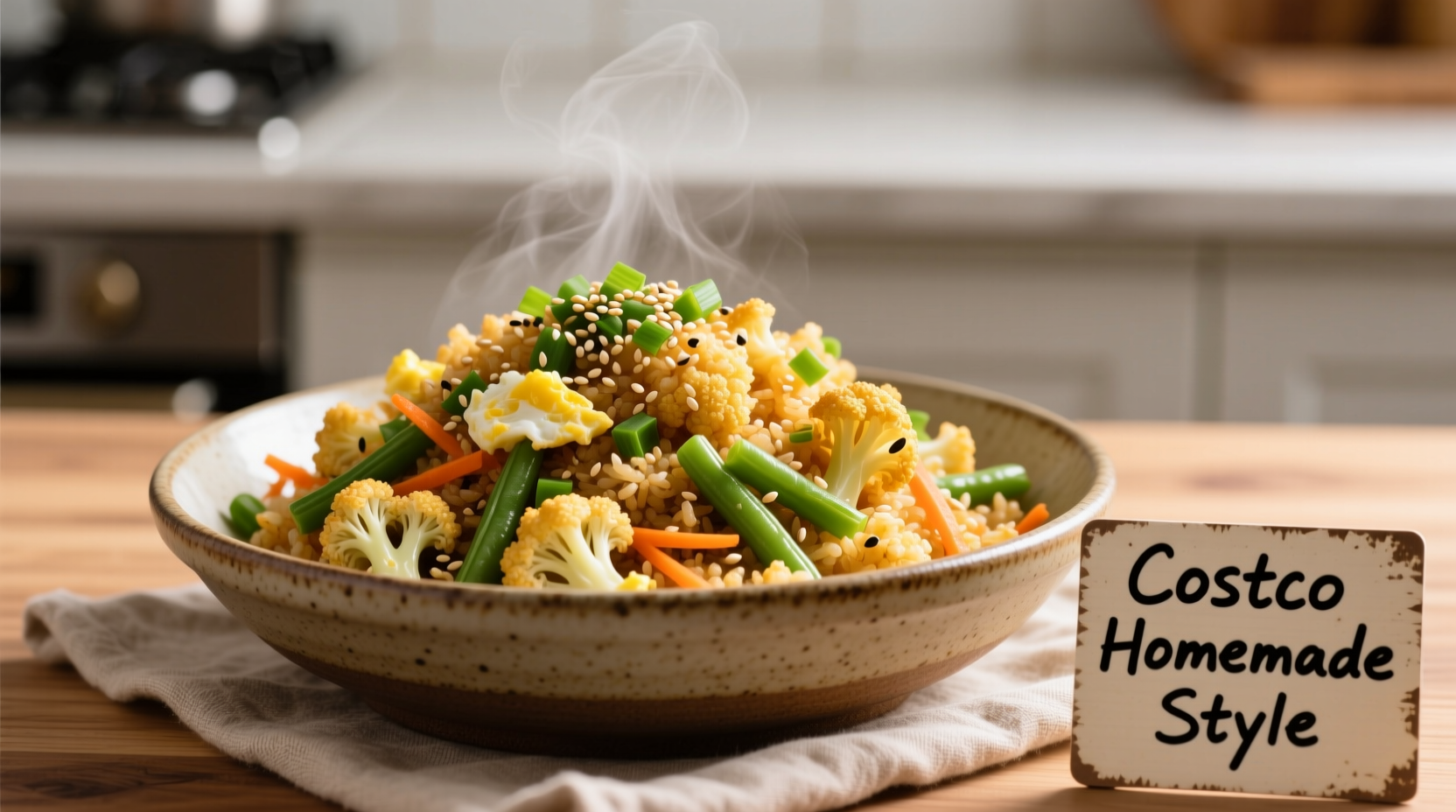Looking for a quick, healthier alternative to traditional fried rice that still satisfies your craving for Asian flavors? Costco's cauliflower fried rice delivers convenience without compromising on taste when prepared properly. This guide reveals exactly what's in the package, how it compares nutritionally to regular fried rice, and professional techniques to transform this pantry staple into a restaurant-quality meal in minutes.
What Exactly Is Costco's Cauliflower Fried Rice?
Costco's cauliflower fried rice (sold under the Kirkland Signature brand) consists of riced cauliflower blended with colorful vegetables like peas, carrots, and sometimes corn. Unlike traditional fried rice made with white rice, this version uses finely chopped cauliflower as the base, creating a lighter dish with significantly fewer carbohydrates. The product comes frozen in large bags, typically 3-4 pounds, making it economical for regular use.
According to product labeling, the ingredients list typically includes: cauliflower, peas, carrots, canola oil, soy sauce (wheat, soybeans), sesame oil, garlic, ginger, and natural flavors. Notably absent are eggs and meat commonly found in restaurant-style fried rice, giving you flexibility to customize with your preferred protein sources.
Nutritional Comparison: Real Numbers That Matter
Understanding the nutritional differences between cauliflower rice and traditional rice is crucial for making informed dietary choices. The table below shows a direct comparison based on USDA FoodData Central measurements:
| Nutrient | Costco Cauliflower Fried Rice (1 cup) | Traditional Fried Rice (1 cup) |
|---|---|---|
| Calories | 60 | 250 |
| Total Carbohydrates | 10g | 45g |
| Dietary Fiber | 5g | 2g |
| Protein | 3g | 7g |
| Sugar | 2g | 1g |
| Fat | 2.5g | 6g |
This nutritional profile makes Costco's version particularly valuable for those following low-carb, keto, or calorie-conscious eating plans. The higher fiber content from cauliflower also promotes better digestion compared to refined white rice.
Professional Cooking Techniques for Best Results
Many consumers report disappointing results with cauliflower rice because they treat it like traditional rice. The key difference? Cauliflower contains significantly more water. When improperly cooked, it becomes soggy rather than achieving that desirable "fried" texture.
Follow these chef-recommended steps for perfect results every time:
- Thaw completely - Unlike regular rice, never cook frozen cauliflower rice directly. Thaw overnight in the refrigerator to remove excess moisture
- Remove additional moisture - After thawing, place in a clean kitchen towel and squeeze gently to extract water
- High-heat cooking - Use a well-heated wok or skillet with minimal oil (1 tsp) to prevent steaming
- Stir-fry, don't simmer - Cook for 3-5 minutes maximum, stirring constantly
- Add protein last - Cook your chicken, shrimp, or tofu separately, then combine at the end

When This Product Shines (And When to Choose Alternatives)
Costco's cauliflower fried rice excels in specific situations but has limitations you should understand:
Ideal for:
- Quick weeknight meals when time is limited
- Low-carb diet adherence without sacrificing familiar flavors
- Increasing vegetable intake for picky eaters
- Meal prep scenarios where consistency matters
Less suitable for:
- Authentic restaurant-style fried rice texture
- Those with cruciferous vegetable sensitivities
- Situations requiring gluten-free options (contains soy sauce with wheat)
- When maximum protein content is the priority
The product represents part of a broader trend in vegetable-based grain alternatives. According to the International Food Information Council's 2024 Food & Health Survey, 68% of consumers actively seek vegetable-based alternatives to traditional carbohydrate sources, with cauliflower rice being the most popular option.
Maximizing Flavor and Satisfaction
To transform this basic product into a satisfying meal, consider these professional enhancements:
- Add one beaten egg during the final minute of cooking for authentic texture
- Boost umami with 1 tsp fish sauce (gluten-free alternative to soy sauce)
- Incorporate toasted sesame seeds for crunch and visual appeal
- Mix in fresh scallions just before serving for brightness
- Finish with a squeeze of lime for acid balance
For those following specific dietary patterns, registered dietitians at the Academy of Nutrition and Dietetics recommend pairing cauliflower rice with adequate protein sources (minimum 20g per meal) to create balanced meals that promote satiety. Their research shows vegetable-based grain alternatives work best when complemented with sufficient protein and healthy fats.











 浙公网安备
33010002000092号
浙公网安备
33010002000092号 浙B2-20120091-4
浙B2-20120091-4